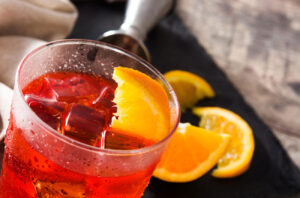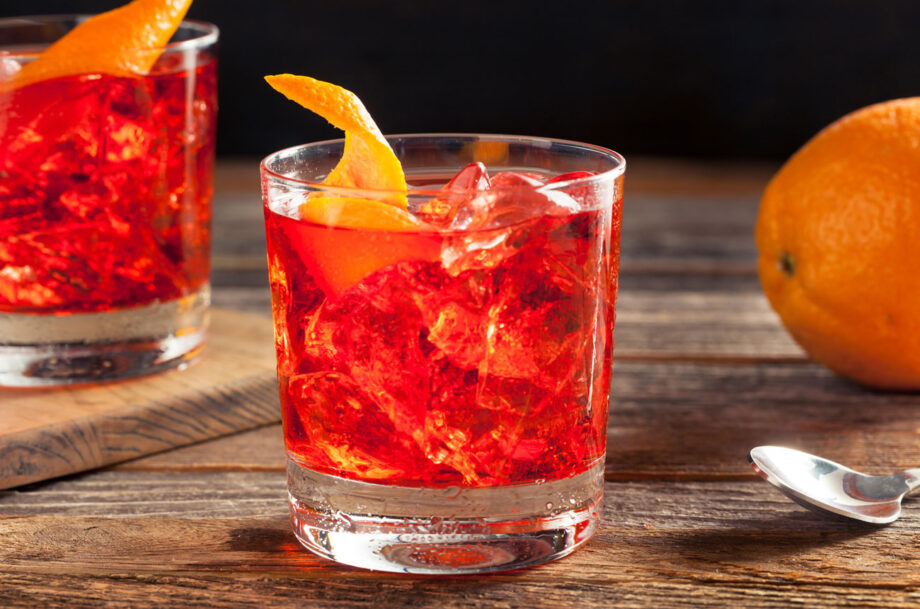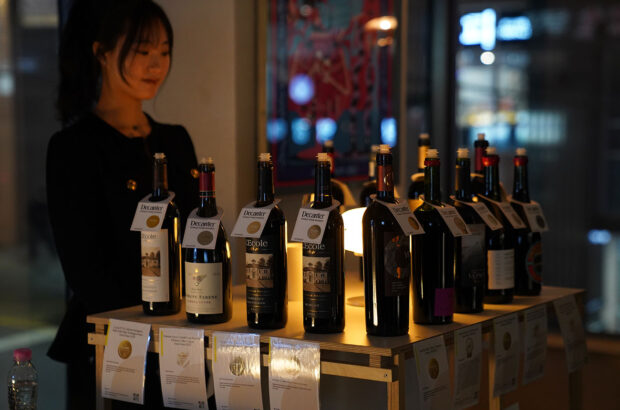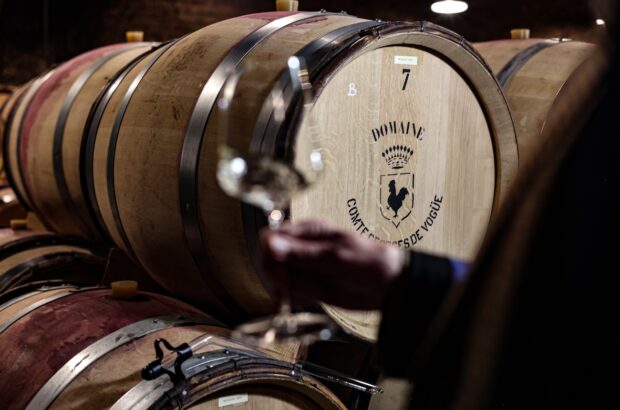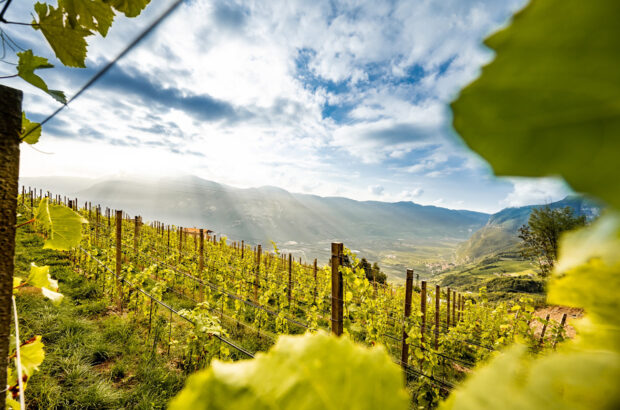There’s something both decadent and comforting about mixing up your own cocktails at home. And for me, the Negroni is the ultimate home serve as it’s just so easy to make.
A Negroni is an equal parts cocktail: this is a drink made up of ingredients measured in identical volumes. To make equal parts cocktails you don’t need any special equipment, you just need one cup or jug or jar – or whatever else you have to hand.

Credit: David Cabrera Navarro / Alamy
You then pour equal measures of your different ingredients into a glass and stir to mix. No fiddly measuring – and you’re guaranteed to get the balance of flavour right every single time!
Who invented the Negroni?
But let’s take a step back: when did people first start drinking Negronis? The cocktail was invented in Italy for Count Camillo Negroni.
{"content":"PHA+SW4gMTkxOSBoZSB2aXNpdGVkIHRoZSBDYWZmw6ggQ2Fzb25pIGluIEZsb3JlbmNlIGFuZCByZXF1ZXN0ZWQgYSBkcmluayB3aXRoIG1vcmUgcHVuY2ggdGhhbiB0aGUgbW9zdCBwb3B1bGFyIGRyaW5rIG9mIHRoZSBkYXkuIFRoYXQgZHJpbmsgd2FzIHRoZSA8YSBocmVmPSJodHRwczovL3d3dy5kZWNhbnRlci5jb20ubWFzdGVyLnB1YmxpYy5rZXlzdG9uZS1wcm9kLWVrcy1ldXcxLmZ1dHVyZXBsYy5lbmdpbmVlcmluZy5tYXN0ZXIucHVibGljLmtleXN0b25lLXByb2QtZWtzLWV1dzEuZnV0dXJlcGxjLmVuZ2luZWVyaW5nL3NwaXJpdHMvYmV5b25kLXRoZS1oaWdoYmFsbC1jb2NrdGFpbHMtdG8tbWFrZS1hdC1ob21lLTUzMzM1My8iIHRhcmdldD0iX2JsYW5rIiByZWw9Im5vb3BlbmVyIj48c3Ryb25nPkFtZXJpY2Fubzwvc3Ryb25nPjwvYT46IGEgbWl4IG9mIENhbXBhcmksIHN3ZWV0IHZlcm1vdXRoIGFuZCBzb2RhIHdhdGVyLjwvcD4KPHA+VGhlIGNhZsOpJiM4MjE3O3MgYmFydGVuZGVyLCBGb3NjbyBTY2Fyc2VsbGksIHN3YXBwZWQgdGhlIHNvZGEgd2F0ZXIgZm9yIGdpbiwgYWRkZWQgYW4gb3JhbmdlIGdhcm5pc2ggKGluc3RlYWTCoCBvZiB0aGUgdXN1YWwgbGVtb24pIGFuZCB0aGUgcmVzdCBpcyBoaXN0b3J5LjwvcD4KPGRpdiBpZD0iYXR0YWNobWVudF81NjM0MTUiIHN0eWxlPSJ3aWR0aDogMzEwcHgiIGNsYXNzPSJ3cC1jYXB0aW9uIGFsaWdubm9uZSI+PGltZyBmZXRjaHByaW9yaXR5PSJoaWdoIiBkZWNvZGluZz0iYXN5bmMiIGFyaWEtZGVzY3JpYmVkYnk9ImNhcHRpb24tYXR0YWNobWVudC01NjM0MTUiIGNsYXNzPSJsYXp5bG9hZCBibHVyLXVwIHNpemUtbWVkaXVtIHdwLWltYWdlLTU2MzQxNSIgZGF0YS1wcm9jZXNzZWQgc3JjPSJodHRwczovL3d3dy5kZWNhbnRlci5jb20ubWFzdGVyLnB1YmxpYy5rZXlzdG9uZS1wcm9kLWVrcy1ldXcxLmZ1dHVyZXBsYy5lbmdpbmVlcmluZy93cC1jb250ZW50L3RoZW1lcy9zaW1iYS10aGVtZS9hc3NldHMvaW1hZ2VzL3BsYWNlaG9sZGVyLnBuZyIgZGF0YS1zcmM9Imh0dHBzOi8va2V5YXNzZXRzLnRpbWVpbmN1ay5uZXQvaW5zcGlyZXdwL2xpdmUvd3AtY29udGVudC91cGxvYWRzL3NpdGVzLzM0LzIwMjEvMDcvQmFydGVuZGVyLU5lZ3JvbmktQWxhbXktMlNKRzZGOS0zMDB4MTk4LmpwZyIgYWx0PSJOZWdyb25pIiB3aWR0aD0iMzAwIiBoZWlnaHQ9IjE5OCIgZGF0YS1zaXplcz0iYXV0byIgZGF0YS1zcmNzZXQ9Imh0dHBzOi8va2V5YXNzZXRzLnRpbWVpbmN1ay5uZXQvaW5zcGlyZXdwL2xpdmUvd3AtY29udGVudC91cGxvYWRzL3NpdGVzLzM0LzIwMjEvMDcvQmFydGVuZGVyLU5lZ3JvbmktQWxhbXktMlNKRzZGOS0zMDB4MTk4LmpwZyAzMDB3LCBodHRwczovL2tleWFzc2V0cy50aW1laW5jdWsubmV0L2luc3BpcmV3cC9saXZlL3dwLWNvbnRlbnQvdXBsb2Fkcy9zaXRlcy8zNC8yMDIxLzA3L0JhcnRlbmRlci1OZWdyb25pLUFsYW15LTJTSkc2RjktNjMweDQxNy5qcGcgNjMwdywgaHR0cHM6Ly9rZXlhc3NldHMudGltZWluY3VrLm5ldC9pbnNwaXJld3AvbGl2ZS93cC1jb250ZW50L3VwbG9hZHMvc2l0ZXMvMzQvMjAyMS8wNy9CYXJ0ZW5kZXItTmVncm9uaS1BbGFteS0yU0pHNkY5LTEzNXg4OS5qcGcgMTM1dywgaHR0cHM6Ly9rZXlhc3NldHMudGltZWluY3VrLm5ldC9pbnNwaXJld3AvbGl2ZS93cC1jb250ZW50L3VwbG9hZHMvc2l0ZXMvMzQvMjAyMS8wNy9CYXJ0ZW5kZXItTmVncm9uaS1BbGFteS0yU0pHNkY5LTMyMHgyMTIuanBnIDMyMHcsIGh0dHBzOi8va2V5YXNzZXRzLnRpbWVpbmN1ay5uZXQvaW5zcGlyZXdwL2xpdmUvd3AtY29udGVudC91cGxvYWRzL3NpdGVzLzM0LzIwMjEvMDcvQmFydGVuZGVyLU5lZ3JvbmktQWxhbXktMlNKRzZGOS02MjB4NDEwLmpwZyA2MjB3LCBodHRwczovL2tleWFzc2V0cy50aW1laW5jdWsubmV0L2luc3BpcmV3cC9saXZlL3dwLWNvbnRlbnQvdXBsb2Fkcy9zaXRlcy8zNC8yMDIxLzA3L0JhcnRlbmRlci1OZWdyb25pLUFsYW15LTJTSkc2RjktOTIweDYwOS5qcGcgOTIwdywgaHR0cHM6Ly9rZXlhc3NldHMudGltZWluY3VrLm5ldC9pbnNwaXJld3AvbGl2ZS93cC1jb250ZW50L3VwbG9hZHMvc2l0ZXMvMzQvMjAyMS8wNy9CYXJ0ZW5kZXItTmVncm9uaS1BbGFteS0yU0pHNkY5LTEyMjB4ODA3LmpwZyAxMjIwdywgaHR0cHM6Ly9rZXlhc3NldHMudGltZWluY3VrLm5ldC9pbnNwaXJld3AvbGl2ZS93cC1jb250ZW50L3VwbG9hZHMvc2l0ZXMvMzQvMjAyMS8wNy9CYXJ0ZW5kZXItTmVncm9uaS1BbGFteS0yU0pHNkY5LmpwZyAxMzAwdyIgc2l6ZXM9IihtYXgtd2lkdGg6IDMwMHB4KSAxMDB2dywgMzAwcHgiIC8+PHAgaWQ9ImNhcHRpb24tYXR0YWNobWVudC01NjM0MTUiIGNsYXNzPSJ3cC1jYXB0aW9uLXRleHQiPkNyZWRpdDogbWF1cml0aXVzIGltYWdlcyBHbWJIIC8gQWxhbXk8L3A+PC9kaXY+CjxkaXYgY2xhc3M9ImFkLWNvbnRhaW5lciBhZC1jb250YWluZXItLW1vYmlsZSI+PGRpdiBpZD0icG9zdC1pbmxpbmUtMyIgY2xhc3M9ImlwYy1hZHZlcnQiPjwvZGl2PjwvZGl2Pgo8aDI+V2hhdCBkb2VzIGEgTmVncm9uaSB0YXN0ZSBsaWtlPzwvaDI+CjxwPlRoZSBOZWdyb25pIGhhcyBiZWNvbWUgYSBjbGFzc2ljIHRoYW5rcyB0byB0aGUgc2ltcGxpY2l0eSBvZiBTY2Fyc2VsbGnigJlzIHJlY2lwZSwgdXNpbmcgZXF1YWwgcGFydHMgPGEgaHJlZj0iaHR0cHM6Ly93d3cuZGVjYW50ZXIuY29tLm1hc3Rlci5wdWJsaWMua2V5c3RvbmUtcHJvZC1la3MtZXV3MS5mdXR1cmVwbGMuZW5naW5lZXJpbmcubWFzdGVyLnB1YmxpYy5rZXlzdG9uZS1wcm9kLWVrcy1ldXcxLmZ1dHVyZXBsYy5lbmdpbmVlcmluZy9zcGlyaXRzL2dpbi8iIHRhcmdldD0iX2JsYW5rIiByZWw9Im5vb3BlbmVyIj48c3Ryb25nPmdpbjwvc3Ryb25nPjwvYT4sIHN3ZWV0IHJlZCA8YSBocmVmPSJodHRwczovL3d3dy5kZWNhbnRlci5jb20ubWFzdGVyLnB1YmxpYy5rZXlzdG9uZS1wcm9kLWVrcy1ldXcxLmZ1dHVyZXBsYy5lbmdpbmVlcmluZy5tYXN0ZXIucHVibGljLmtleXN0b25lLXByb2QtZWtzLWV1dzEuZnV0dXJlcGxjLmVuZ2luZWVyaW5nL2xlYXJuL2RlY2FudGVycy1jb21wbGV0ZS1ndWlkZS10by12ZXJtb3V0aC00NTUxMTMvIj48c3Ryb25nPnZlcm1vdXRoPC9zdHJvbmc+PC9hPiBhbmQgPGEgaHJlZj0iaHR0cHM6Ly93d3cuZGVjYW50ZXIuY29tLm1hc3Rlci5wdWJsaWMua2V5c3RvbmUtcHJvZC1la3MtZXV3MS5mdXR1cmVwbGMuZW5naW5lZXJpbmcubWFzdGVyLnB1YmxpYy5rZXlzdG9uZS1wcm9kLWVrcy1ldXcxLmZ1dHVyZXBsYy5lbmdpbmVlcmluZy9sZWFybi90aGUtcmlzZS1pbi1iaXR0ZXJzLWNvY2t0YWlscy00MjU2NzctNDI1Njc3LyI+PHN0cm9uZz5hbWFybzwvc3Ryb25nPjwvYT4uIFRvZ2V0aGVyIHRoZXkgY3JlYXRlIGEgc3Ryb25nLCBiaXR0ZXJzd2VldCwgaGVyYmFsIGRyaW5rLjwvcD4KPHA+QWxvbmdzaWRlIHRoZSBnaW4sIGl04oCZcyB0aGUgZHJ5IGFtYXJvIOKAkyBhIGhlcmJhbCBsaXF1ZXVyIHRoYXTigJlzIGFsc28ga25vd24gYXMgYXBlcml0aXZvIG9yIGJpdHRlcnMg4oCTIHRoYXQgaGVscHMgdG8gbWFrZSB0aGUgTmVncm9uaSBzdWNoIGEgZ29vZCBhcGVyaXRpZi48L3A+CjxkaXYgY2xhc3M9ImFkLWNvbnRhaW5lciBhZC1jb250YWluZXItLW1vYmlsZSI+PGRpdiBpZD0icG9zdC1pbmxpbmUtNCIgY2xhc3M9ImlwYy1hZHZlcnQiPjwvZGl2PjwvZGl2Pgo8cD5Gb2xsb3cgdGhlIHJlY2lwZSBhbmQgaW5zdHJ1Y3Rpb25zIGJlbG93IHRvIG1ha2Ugb25lIHlvdXJzZWxmIGF0IGhvbWUuPC9wPgo8ZGl2IGNsYXNzPSJicmVha291dCBwYWxldHRlLWEgcGFuZWwgcGFuZWwtZGVmYXVsdCI+PGRpdiBjbGFzcz0icGFuZWwtYm9keSI+PGRpdiBjbGFzcz0nYnJlYWtvdXQtY29udGVudCc+PC9wPgo8ZGl2IGNsYXNzPSJhZC1jb250YWluZXIgYWQtY29udGFpbmVyLS1tb2JpbGUiPgo8ZGl2IGlkPSJwb3N0LWlubGluZS01IiBjbGFzcz0iaXBjLWFkdmVydCI+PC9kaXY+CjwvZGl2Pgo8aDIgc3R5bGU9InRleHQtYWxpZ246IGNlbnRlciI+SG93IHRvIG1ha2UgYSBOZWdyb25pPC9oMj4KPHAgc3R5bGU9InRleHQtYWxpZ246IGNlbnRlciI+PHN0cm9uZz5HbGFzczo8L3N0cm9uZz4gUm9ja3M8YnIgLz4KPHN0cm9uZz5HYXJuaXNoOjwvc3Ryb25nPiBPcmFuZ2UgcGVlbDxiciAvPgo8c3Ryb25nPk1ldGhvZDo8L3N0cm9uZz4gUG91ciB0aGUgZ2luLCB2ZXJtb3V0aCBhbmQgQ2FtcGFyaSBpbnRvIGEgbWl4aW5nIGdsYXNzIG9yIHNoYWtlciBmaWxsZWQgd2l0aCBpY2UgYW5kIHN0aXIgdG8gbWl4LiBTdHJhaW4gaW50byBhIHJvY2tzIGdsYXNzIGZpbGxlZCB3aXRoIGljZSBhbmQgZ2FybmlzaC48YnIgLz4KPGVtPjMwbWwgZ2luPC9lbT48YnIgLz4KPGVtPjMwbWwgc3dlZXQgcmVkIHZlcm1vdXRoPC9lbT48YnIgLz4KPGVtPjMwbWwgQ2FtcGFyaTwvZW0+PC9wPgo8cD4KPC9kaXY+PGRpdiBjbGFzcz0nYnJlYWtvdXQtYnV0dG9ucyc+PGRpdiBjbGFzcz0ncm93Jz48L2Rpdj48L2Rpdj48L2Rpdj48L2Rpdj4KPGRpdiBpZD0iYXR0YWNobWVudF81NjM0MTMiIHN0eWxlPSJ3aWR0aDogMzEwcHgiIGNsYXNzPSJ3cC1jYXB0aW9uIGFsaWdubm9uZSI+PGltZyBkZWNvZGluZz0iYXN5bmMiIGFyaWEtZGVzY3JpYmVkYnk9ImNhcHRpb24tYXR0YWNobWVudC01NjM0MTMiIGNsYXNzPSJsYXp5bG9hZCBibHVyLXVwIHNpemUtbWVkaXVtIHdwLWltYWdlLTU2MzQxMyIgZGF0YS1wcm9jZXNzZWQgc3JjPSJodHRwczovL3d3dy5kZWNhbnRlci5jb20ubWFzdGVyLnB1YmxpYy5rZXlzdG9uZS1wcm9kLWVrcy1ldXcxLmZ1dHVyZXBsYy5lbmdpbmVlcmluZy93cC1jb250ZW50L3RoZW1lcy9zaW1iYS10aGVtZS9hc3NldHMvaW1hZ2VzL3BsYWNlaG9sZGVyLnBuZyIgZGF0YS1zcmM9Imh0dHBzOi8va2V5YXNzZXRzLnRpbWVpbmN1ay5uZXQvaW5zcGlyZXdwL2xpdmUvd3AtY29udGVudC91cGxvYWRzL3NpdGVzLzM0LzIwMjEvMDcvTWFraW5nLU5lZ3JvbmktQWxhbXktMkEyQUdDMi0zMDB4MTk4LmpwZyIgYWx0PSJNYWtpbmcgTmVncm9uaSIgd2lkdGg9IjMwMCIgaGVpZ2h0PSIxOTgiIGRhdGEtc2l6ZXM9ImF1dG8iIGRhdGEtc3Jjc2V0PSJodHRwczovL2tleWFzc2V0cy50aW1laW5jdWsubmV0L2luc3BpcmV3cC9saXZlL3dwLWNvbnRlbnQvdXBsb2Fkcy9zaXRlcy8zNC8yMDIxLzA3L01ha2luZy1OZWdyb25pLUFsYW15LTJBMkFHQzItMzAweDE5OC5qcGcgMzAwdywgaHR0cHM6Ly9rZXlhc3NldHMudGltZWluY3VrLm5ldC9pbnNwaXJld3AvbGl2ZS93cC1jb250ZW50L3VwbG9hZHMvc2l0ZXMvMzQvMjAyMS8wNy9NYWtpbmctTmVncm9uaS1BbGFteS0yQTJBR0MyLTYzMHg0MTcuanBnIDYzMHcsIGh0dHBzOi8va2V5YXNzZXRzLnRpbWVpbmN1ay5uZXQvaW5zcGlyZXdwL2xpdmUvd3AtY29udGVudC91cGxvYWRzL3NpdGVzLzM0LzIwMjEvMDcvTWFraW5nLU5lZ3JvbmktQWxhbXktMkEyQUdDMi0xMzV4ODkuanBnIDEzNXcsIGh0dHBzOi8va2V5YXNzZXRzLnRpbWVpbmN1ay5uZXQvaW5zcGlyZXdwL2xpdmUvd3AtY29udGVudC91cGxvYWRzL3NpdGVzLzM0LzIwMjEvMDcvTWFraW5nLU5lZ3JvbmktQWxhbXktMkEyQUdDMi0zMjB4MjEyLmpwZyAzMjB3LCBodHRwczovL2tleWFzc2V0cy50aW1laW5jdWsubmV0L2luc3BpcmV3cC9saXZlL3dwLWNvbnRlbnQvdXBsb2Fkcy9zaXRlcy8zNC8yMDIxLzA3L01ha2luZy1OZWdyb25pLUFsYW15LTJBMkFHQzItNjIweDQxMC5qcGcgNjIwdywgaHR0cHM6Ly9rZXlhc3NldHMudGltZWluY3VrLm5ldC9pbnNwaXJld3AvbGl2ZS93cC1jb250ZW50L3VwbG9hZHMvc2l0ZXMvMzQvMjAyMS8wNy9NYWtpbmctTmVncm9uaS1BbGFteS0yQTJBR0MyLTkyMHg2MDkuanBnIDkyMHcsIGh0dHBzOi8va2V5YXNzZXRzLnRpbWVpbmN1ay5uZXQvaW5zcGlyZXdwL2xpdmUvd3AtY29udGVudC91cGxvYWRzL3NpdGVzLzM0LzIwMjEvMDcvTWFraW5nLU5lZ3JvbmktQWxhbXktMkEyQUdDMi0xMjIweDgwNy5qcGcgMTIyMHcsIGh0dHBzOi8va2V5YXNzZXRzLnRpbWVpbmN1ay5uZXQvaW5zcGlyZXdwL2xpdmUvd3AtY29udGVudC91cGxvYWRzL3NpdGVzLzM0LzIwMjEvMDcvTWFraW5nLU5lZ3JvbmktQWxhbXktMkEyQUdDMi5qcGcgMTMwMHciIHNpemVzPSIobWF4LXdpZHRoOiAzMDBweCkgMTAwdncsIDMwMHB4IiAvPjxwIGlkPSJjYXB0aW9uLWF0dGFjaG1lbnQtNTYzNDEzIiBjbGFzcz0id3AtY2FwdGlvbi10ZXh0Ij5DcmVkaXQ6IFNpbW9uIEJ1cnQgLyBBbGFteTwvcD48L2Rpdj4KPGgyPlR3aXN0cyBvbiB0aGUgY2xhc3NpYzwvaDI+CjxwPlRoZSBzdHJvbmcsIGJpdHRlcnN3ZWV0IHRhc3RlIG9mIGEgTmVncm9uaSBjYW4gYmUgb2ZmLXB1dHRpbmcgZm9yIHNvbWUgY29ja3RhaWwgbG92ZXJzLiBCdXQgYW5vdGhlciBiZW5lZml0IG9mIGhhdmluZyBhIHNpbXBsZSByZWNpcGUgaXMgdGhhdCB5b3UgY2FuIGVhc2lseSBwbGF5IHdpdGggdGhlIG1peCBvZiBpbmdyZWRpZW50cywgYXMgbG9uZyBhcyB5b3Uga2VlcCB0aGUgcmF0aW8gdGhlIHNhbWUuPC9wPgo8cD48YSBocmVmPSJodHRwczovL3RhcmdldC5nZW9yaW90LmNvbS9Qcm94eS5hc2h4P3RzaWQ9MTEyODIzJmFtcDtHUl9VUkw9aHR0cHMlM0ElMkYlMkZhbWF6b24uY28udWslMkZDYW1wYXJpLUJpdHRlci03MC1jbCUyRmRwJTJGQjAwM1pJVTFPNCUzRnRoJTNEMSUyNnRhZyUzRGhhd2stZnV0dXJlLTIxJTI2YXNjc3VidGFnJTNEZGVjYW50ZXItZ2ItMTAwODU5MTMyNTk4MjQ3NjA5MC0yMSIgdGFyZ2V0PSJfYmxhbmsiIHJlbD0ibm9vcGVuZXIiPjxzdHJvbmc+Q2FtcGFyaTwvc3Ryb25nPiA8L2E+aXMgdGhlIHN0YW5kYXJkIGNob2ljZSBmb3IgYSBOZWdyb25pLCBidXQgdGhlcmUgYXJlIG90aGVyIGJyYW5kcyBvZiBhbWFyb3MgdGhhdCBhcmUgbGVzcyBiaXR0ZXIuIFRyeSB0aGUgVmVuZXRpYW4gPGEgaHJlZj0iaHR0cHM6Ly93d3cuYXdpbjEuY29tL2F3Y2xpY2sucGhwP2F3aW5taWQ9NDAwJmFtcDthd2luYWZmaWQ9MTAzNTA0JmFtcDtjbGlja3JlZj1kZWNhbnRlci1nYi0xMzIxODE0ODk1ODM3MzMwNTY2JmFtcDtwPWh0dHBzJTNBJTJGJTJGd3d3LnRoZXdoaXNreWV4Y2hhbmdlLmNvbSUyRnAlMkYzMzUwMiUyRnNlbGVjdC1hcGVyaXRpdm8iIHRhcmdldD0iX2JsYW5rIiByZWw9Im5vb3BlbmVyIj48c3Ryb25nPlNlbGVjdCBBcGVyaXRpdm88L3N0cm9uZz48L2E+IGFzIGEgbW9yZSBhcHByb2FjaGFibGUgb3B0aW9uLjwvcD4KPHA+RGlhbCB0aGluZ3MgYmFjayBmdXJ0aGVyIGJ5IHVzaW5nIHN3ZWV0ZXIgPGEgaHJlZj0iaHR0cHM6Ly90YXJnZXQuZ2VvcmlvdC5jb20vUHJveHkuYXNoeD90c2lkPTExMjgyMyZhbXA7R1JfVVJMPWh0dHBzJTNBJTJGJTJGYW1hem9uLmNvLnVrJTJGQXBlcm9sLTQtQUUtMDAxLTExLUFwZXJpdGl2by03MC1jbCUyRmRwJTJGQjAwMjlONVNFRSUzRnRoJTNEMSUyNnRhZyUzRGhhd2stZnV0dXJlLTIxJTI2YXNjc3VidGFnJTNEZGVjYW50ZXItZ2ItMTQzMTM1NjkwMTE0MTk4MDQzMi0yMSIgdGFyZ2V0PSJfYmxhbmsiIHJlbD0ibm9vcGVuZXIiPjxzdHJvbmc+QXBlcm9sPC9zdHJvbmc+PC9hPiBhbmQgYSByb3PDqSB2ZXJtb3V0aCBmb3IgYSBsZXNzIHB1bmNoeSBjb2NrdGFpbC48L3A+CjxkaXYgaWQ9ImF0dGFjaG1lbnRfNTYzNDE2IiBzdHlsZT0id2lkdGg6IDMxMHB4IiBjbGFzcz0id3AtY2FwdGlvbiBhbGlnbm5vbmUiPjxpbWcgZGVjb2Rpbmc9ImFzeW5jIiBhcmlhLWRlc2NyaWJlZGJ5PSJjYXB0aW9uLWF0dGFjaG1lbnQtNTYzNDE2IiBjbGFzcz0ibGF6eWxvYWQgYmx1ci11cCBzaXplLW1lZGl1bSB3cC1pbWFnZS01NjM0MTYiIGRhdGEtcHJvY2Vzc2VkIHNyYz0iaHR0cHM6Ly93d3cuZGVjYW50ZXIuY29tLm1hc3Rlci5wdWJsaWMua2V5c3RvbmUtcHJvZC1la3MtZXV3MS5mdXR1cmVwbGMuZW5naW5lZXJpbmcvd3AtY29udGVudC90aGVtZXMvc2ltYmEtdGhlbWUvYXNzZXRzL2ltYWdlcy9wbGFjZWhvbGRlci5wbmciIGRhdGEtc3JjPSJodHRwczovL2tleWFzc2V0cy50aW1laW5jdWsubmV0L2luc3BpcmV3cC9saXZlL3dwLWNvbnRlbnQvdXBsb2Fkcy9zaXRlcy8zNC8yMDIxLzA3L1doaXRlLU5lZ3JvbmktQWxhbXktMkM3SFJXMS0zMDB4MTk4LmpwZyIgYWx0PSJXaGl0ZSBOZWdyb25pIiB3aWR0aD0iMzAwIiBoZWlnaHQ9IjE5OCIgZGF0YS1zaXplcz0iYXV0byIgZGF0YS1zcmNzZXQ9Imh0dHBzOi8va2V5YXNzZXRzLnRpbWVpbmN1ay5uZXQvaW5zcGlyZXdwL2xpdmUvd3AtY29udGVudC91cGxvYWRzL3NpdGVzLzM0LzIwMjEvMDcvV2hpdGUtTmVncm9uaS1BbGFteS0yQzdIUlcxLTMwMHgxOTguanBnIDMwMHcsIGh0dHBzOi8va2V5YXNzZXRzLnRpbWVpbmN1ay5uZXQvaW5zcGlyZXdwL2xpdmUvd3AtY29udGVudC91cGxvYWRzL3NpdGVzLzM0LzIwMjEvMDcvV2hpdGUtTmVncm9uaS1BbGFteS0yQzdIUlcxLTYzMHg0MTcuanBnIDYzMHcsIGh0dHBzOi8va2V5YXNzZXRzLnRpbWVpbmN1ay5uZXQvaW5zcGlyZXdwL2xpdmUvd3AtY29udGVudC91cGxvYWRzL3NpdGVzLzM0LzIwMjEvMDcvV2hpdGUtTmVncm9uaS1BbGFteS0yQzdIUlcxLTEzNXg4OS5qcGcgMTM1dywgaHR0cHM6Ly9rZXlhc3NldHMudGltZWluY3VrLm5ldC9pbnNwaXJld3AvbGl2ZS93cC1jb250ZW50L3VwbG9hZHMvc2l0ZXMvMzQvMjAyMS8wNy9XaGl0ZS1OZWdyb25pLUFsYW15LTJDN0hSVzEtMzIweDIxMi5qcGcgMzIwdywgaHR0cHM6Ly9rZXlhc3NldHMudGltZWluY3VrLm5ldC9pbnNwaXJld3AvbGl2ZS93cC1jb250ZW50L3VwbG9hZHMvc2l0ZXMvMzQvMjAyMS8wNy9XaGl0ZS1OZWdyb25pLUFsYW15LTJDN0hSVzEtNjIweDQxMC5qcGcgNjIwdywgaHR0cHM6Ly9rZXlhc3NldHMudGltZWluY3VrLm5ldC9pbnNwaXJld3AvbGl2ZS93cC1jb250ZW50L3VwbG9hZHMvc2l0ZXMvMzQvMjAyMS8wNy9XaGl0ZS1OZWdyb25pLUFsYW15LTJDN0hSVzEtOTIweDYwOS5qcGcgOTIwdywgaHR0cHM6Ly9rZXlhc3NldHMudGltZWluY3VrLm5ldC9pbnNwaXJld3AvbGl2ZS93cC1jb250ZW50L3VwbG9hZHMvc2l0ZXMvMzQvMjAyMS8wNy9XaGl0ZS1OZWdyb25pLUFsYW15LTJDN0hSVzEtMTIyMHg4MDcuanBnIDEyMjB3LCBodHRwczovL2tleWFzc2V0cy50aW1laW5jdWsubmV0L2luc3BpcmV3cC9saXZlL3dwLWNvbnRlbnQvdXBsb2Fkcy9zaXRlcy8zNC8yMDIxLzA3L1doaXRlLU5lZ3JvbmktQWxhbXktMkM3SFJXMS5qcGcgMTMwMHciIHNpemVzPSIobWF4LXdpZHRoOiAzMDBweCkgMTAwdncsIDMwMHB4IiAvPjxwIGlkPSJjYXB0aW9uLWF0dGFjaG1lbnQtNTYzNDE2IiBjbGFzcz0id3AtY2FwdGlvbi10ZXh0Ij5DcmVkaXQ6IEJyZW50IEhvZmFja2VyIC8gQWxhbXk8L3A+PC9kaXY+CjxwPkFsdGVybmF0aXZlbHksIHRyeSBhIFdoaXRlIE5lZ3JvbmkgKGFib3ZlKS4gVGhpcyBGcmVuY2ggdHdpc3Qgb24gYSBOZWdyb25pIHJlcGxhY2VzIENhbXBhcmkgd2l0aCA8YSBocmVmPSJodHRwczovL3RhcmdldC5nZW9yaW90LmNvbS9Qcm94eS5hc2h4P3RzaWQ9MTEyODIzJmFtcDtHUl9VUkw9aHR0cHMlM0ElMkYlMkZhbWF6b24uY28udWslMkZTdXplLTA0MTEyQi1MaXF1ZXVyLTcwLWNsJTJGZHAlMkZCMDdOS1NCRzdWJTNGdGFnJTNEaGF3ay1mdXR1cmUtMjElMjZhc2NzdWJ0YWclM0RkZWNhbnRlci1nYi0xMjk3OTI4MzY4NjI5MDU2Mjc3LTIxIiB0YXJnZXQ9Il9ibGFuayIgcmVsPSJub29wZW5lciI+PHN0cm9uZz5TdXplPC9zdHJvbmc+PC9hPiAoYSBnZW50aWFuLWJhc2VkIEZyZW5jaCBiaXR0ZXIpIGFuZCB1c2VzIGEgRnJlbmNoIHdoaXRlIHZlcm1vdXRoIDxhIGhyZWY9Imh0dHBzOi8vdGFyZ2V0Lmdlb3Jpb3QuY29tL1Byb3h5LmFzaHg\/dHNpZD0xMTI4MjMmYW1wO0dSX1VSTD1odHRwcyUzQSUyRiUyRmFtYXpvbi5jby51ayUyRkxpbGxldC1CbGFuYy1XaW5lLUJhc2VkLUFwZXJpdGlmLTc1JTJGZHAlMkZCMDA0RUFNQUtBJTJGcmVmJTNEc3JfMV8xX3NzcGElM0Z0YWclM0RoYXdrLWZ1dHVyZS0yMSUyNmFzY3N1YnRhZyUzRGRlY2FudGVyLWdiLTEzNjY1NjI2NDA2NDY2MzkyMDEtMjEiIHRhcmdldD0iX2JsYW5rIiByZWw9Im5vb3BlbmVyIj48c3Ryb25nPkxpbGxldCBCbGFuYzwvc3Ryb25nPjwvYT4uIEl0IHdhcyBpbnZlbnRlZCBpbiAyMDAxIGJ5IHRoZSBsYXRlIGFuZCBncmVhdCBCcml0aXNoIGJhcnRlbmRlciBXYXluZSBDb2xsaW5zLCBhdCBkcmlua3MgdHJhZGUgc2hvdyBWaW5FeHBvIGluIFBhcmlzLjwvcD4KPHA+Q29sbGlucyB3YXMgdGFraW5nIHBhcnQgaW4gYSBjb2NrdGFpbCBjb21wZXRpdGlvbiBmb3IgUGx5bW91dGggR2luLiBIaXMgZHJpbmsgd29uIGFuZCBoYXMgZ29uZSBvbiB0byBiZWNvbWUgYSBtb2Rlcm4gY2xhc3NpYy4gRmxhdm91cmVkIHdpdGggZ2VudGlhbiByb290LCBTdXplIGlzIG1vcmUgZGVsaWNhdGUgdGhhbiBDYW1wYXJpLCB3aXRoIGRyaWVkIGhlcmJzIGFuZCBjaXRydXMgcGVlbCBub3RlcywgYnV0IHRoZSBzYW1lIGJpdHRlcnN3ZWV0IGludGVuc2l0eS48L3A+CjxkaXYgY2xhc3M9ImJyZWFrb3V0IHBhbGV0dGUtYSBwYW5lbCBwYW5lbC1kZWZhdWx0Ij48ZGl2IGNsYXNzPSJwYW5lbC1ib2R5Ij48ZGl2IGNsYXNzPSdicmVha291dC1jb250ZW50Jz48L3A+CjxoMiBzdHlsZT0idGV4dC1hbGlnbjogY2VudGVyIj5Ib3cgdG8gbWFrZSBhIFdoaXRlIE5lZ3Jvbmk8L2gyPgo8cCBzdHlsZT0idGV4dC1hbGlnbjogY2VudGVyIj48c3Ryb25nPkdsYXNzOjwvc3Ryb25nPiBSb2NrczxiciAvPgo8c3Ryb25nPkdhcm5pc2g6PC9zdHJvbmc+IEdyYXBlZnJ1aXQgdHdpc3Q8YnIgLz4KPHN0cm9uZz5NZXRob2Q6PC9zdHJvbmc+IFBvdXIgdGhlIGdpbiwgdmVybW91dGggYW5kIFN1emUgaW50byBhIG1peGluZyBnbGFzcyBvciBzaGFrZXIgZmlsbGVkIHdpdGggaWNlIGFuZCBzdGlyIHRvIG1peC4gU3RyYWluIGludG8gYSByb2NrcyBnbGFzcyBmaWxsZWQgd2l0aCBpY2UgYW5kIGdhcm5pc2guPGJyIC8+CjxlbT4zMG1sIGdpbjwvZW0+PGJyIC8+CjxlbT4zMG1sIHdoaXRlIHZlcm1vdXRoPC9lbT48YnIgLz4KPGVtPjMwbWwgU3V6ZTwvZW0+PC9wPgo8cD4KPC9kaXY+PGRpdiBjbGFzcz0nYnJlYWtvdXQtYnV0dG9ucyc+PGRpdiBjbGFzcz0ncm93Jz48L2Rpdj48L2Rpdj48L2Rpdj48L2Rpdj4KPGRpdiBpZD0iYXR0YWNobWVudF81NjM0MTkiIHN0eWxlPSJ3aWR0aDogMzEwcHgiIGNsYXNzPSJ3cC1jYXB0aW9uIGFsaWdubm9uZSI+PGltZyBsb2FkaW5nPSJsYXp5IiBkZWNvZGluZz0iYXN5bmMiIGFyaWEtZGVzY3JpYmVkYnk9ImNhcHRpb24tYXR0YWNobWVudC01NjM0MTkiIGNsYXNzPSJsYXp5bG9hZCBibHVyLXVwIHNpemUtbWVkaXVtIHdwLWltYWdlLTU2MzQxOSIgZGF0YS1wcm9jZXNzZWQgc3JjPSJodHRwczovL3d3dy5kZWNhbnRlci5jb20ubWFzdGVyLnB1YmxpYy5rZXlzdG9uZS1wcm9kLWVrcy1ldXcxLmZ1dHVyZXBsYy5lbmdpbmVlcmluZy93cC1jb250ZW50L3RoZW1lcy9zaW1iYS10aGVtZS9hc3NldHMvaW1hZ2VzL3BsYWNlaG9sZGVyLnBuZyIgZGF0YS1zcmM9Imh0dHBzOi8va2V5YXNzZXRzLnRpbWVpbmN1ay5uZXQvaW5zcGlyZXdwL2xpdmUvd3AtY29udGVudC91cGxvYWRzL3NpdGVzLzM0LzIwMjEvMDcvTWFraW5nLXdoaXRlLU5lZ3JvbmktRjROMVQ1LTMwMHg0NTMuanBnIiBhbHQ9IldoaXRlIE5lZ3JvbmkiIHdpZHRoPSIzMDAiIGhlaWdodD0iNDUzIiBkYXRhLXNpemVzPSJhdXRvIiBkYXRhLXNyY3NldD0iaHR0cHM6Ly9rZXlhc3NldHMudGltZWluY3VrLm5ldC9pbnNwaXJld3AvbGl2ZS93cC1jb250ZW50L3VwbG9hZHMvc2l0ZXMvMzQvMjAyMS8wNy9NYWtpbmctd2hpdGUtTmVncm9uaS1GNE4xVDUtMzAweDQ1My5qcGcgMzAwdywgaHR0cHM6Ly9rZXlhc3NldHMudGltZWluY3VrLm5ldC9pbnNwaXJld3AvbGl2ZS93cC1jb250ZW50L3VwbG9hZHMvc2l0ZXMvMzQvMjAyMS8wNy9NYWtpbmctd2hpdGUtTmVncm9uaS1GNE4xVDUtNTQ5eDgzMC5qcGcgNTQ5dywgaHR0cHM6Ly9rZXlhc3NldHMudGltZWluY3VrLm5ldC9pbnNwaXJld3AvbGl2ZS93cC1jb250ZW50L3VwbG9hZHMvc2l0ZXMvMzQvMjAyMS8wNy9NYWtpbmctd2hpdGUtTmVncm9uaS1GNE4xVDUtODl4MTM1LmpwZyA4OXcsIGh0dHBzOi8va2V5YXNzZXRzLnRpbWVpbmN1ay5uZXQvaW5zcGlyZXdwL2xpdmUvd3AtY29udGVudC91cGxvYWRzL3NpdGVzLzM0LzIwMjEvMDcvTWFraW5nLXdoaXRlLU5lZ3JvbmktRjROMVQ1LTIxMngzMjAuanBnIDIxMncsIGh0dHBzOi8va2V5YXNzZXRzLnRpbWVpbmN1ay5uZXQvaW5zcGlyZXdwL2xpdmUvd3AtY29udGVudC91cGxvYWRzL3NpdGVzLzM0LzIwMjEvMDcvTWFraW5nLXdoaXRlLU5lZ3JvbmktRjROMVQ1LTQxMHg2MjAuanBnIDQxMHcsIGh0dHBzOi8va2V5YXNzZXRzLnRpbWVpbmN1ay5uZXQvaW5zcGlyZXdwL2xpdmUvd3AtY29udGVudC91cGxvYWRzL3NpdGVzLzM0LzIwMjEvMDcvTWFraW5nLXdoaXRlLU5lZ3JvbmktRjROMVQ1LTYwOXg5MjAuanBnIDYwOXcsIGh0dHBzOi8va2V5YXNzZXRzLnRpbWVpbmN1ay5uZXQvaW5zcGlyZXdwL2xpdmUvd3AtY29udGVudC91cGxvYWRzL3NpdGVzLzM0LzIwMjEvMDcvTWFraW5nLXdoaXRlLU5lZ3JvbmktRjROMVQ1LTgwN3gxMjIwLmpwZyA4MDd3LCBodHRwczovL2tleWFzc2V0cy50aW1laW5jdWsubmV0L2luc3BpcmV3cC9saXZlL3dwLWNvbnRlbnQvdXBsb2Fkcy9zaXRlcy8zNC8yMDIxLzA3L01ha2luZy13aGl0ZS1OZWdyb25pLUY0TjFUNS5qcGcgODYwdyIgc2l6ZXM9IihtYXgtd2lkdGg6IDMwMHB4KSAxMDB2dywgMzAwcHgiIC8+PHAgaWQ9ImNhcHRpb24tYXR0YWNobWVudC01NjM0MTkiIGNsYXNzPSJ3cC1jYXB0aW9uLXRleHQiPkNyZWRpdDogTXVyYWQgUk0gLyBBbGFteTwvcD48L2Rpdj4KPGgyPldoYXQgZ2luIHRvIHVzZT88L2gyPgo8ZGl2IGNsYXNzPSJpbmplY3Rpb24iPjwvZGl2Pgo8cD5XaGF0ZXZlciB2ZXJzaW9uwqAgb2YgdGhlIGNvY2t0YWlsIHlvdSBwcmVmZXIsIHlvdXIgY2hvaWNlIG9mIGdpbiBwbGF5cyBhIGtleSByb2xlIGluIHRoZSBmaW5hbCBmbGF2b3VyIG9mIHlvdXIgTmVncm9uaS4gSnVuaXBlci1sZWQgPGEgaHJlZj0iaHR0cHM6Ly93d3cuZGVjYW50ZXIuY29tLm1hc3Rlci5wdWJsaWMua2V5c3RvbmUtcHJvZC1la3MtZXV3MS5mdXR1cmVwbGMuZW5naW5lZXJpbmcubWFzdGVyLnB1YmxpYy5rZXlzdG9uZS1wcm9kLWVrcy1ldXcxLmZ1dHVyZXBsYy5lbmdpbmVlcmluZy9zcGlyaXRzL3doYXQtaXMtbG9uZG9uLWRyeS1naW4tYXNrLWRlY2FudGVyLTQ1MTg2NS8iPjxzdHJvbmc+TG9uZG9uIERyeTwvc3Ryb25nPjwvYT4gc3R5bGVzIHdvcmsgYmVzdCBoZXJlOiB5b3XigJlyZSBsb29raW5nIGZvciBzb21ldGhpbmcgdGhhdCB3aWxsIHN0YW5kIHVwIHRvIHRoZSBzdHJvbmcsIGJpdHRlciBmbGF2b3VycyBvZiB0aGUgQ2FtcGFyaSwgYXMgd2VsbCBhcyB0aGUgaGVyYmFsIHZlcm1vdXRoLjwvcD4KPHA+QWxvbmdzaWRlIHRoZSBvYnZpb3VzIGp1bmlwZXIgY29tcG9uZW50IG9mIExvbmRvbiBEcnksIGdpbnMgd2l0aCBkaXN0aW5jdGl2ZSA8YSBocmVmPSJodHRwczovL3d3dy5kZWNhbnRlci5jb20ubWFzdGVyLnB1YmxpYy5rZXlzdG9uZS1wcm9kLWVrcy1ldXcxLmZ1dHVyZXBsYy5lbmdpbmVlcmluZy5tYXN0ZXIucHVibGljLmtleXN0b25lLXByb2QtZWtzLWV1dzEuZnV0dXJlcGxjLmVuZ2luZWVyaW5nL3NwaXJpdHMtMS9naW4tYm90YW5pY2Fscy1wbHVzLXRlbi10by10cnktNDQxMTM3LyI+PHN0cm9uZz5ib3RhbmljYWxzPC9zdHJvbmc+PC9hPiDigJMgd2hldGhlciB0aGF04oCZcyBjaXRydXMsIHNwaWNlIG9yIGhlcmJzIOKAkyBjYW4gYWRkIGluZGl2aWR1YWwgY2hhcmFjdGVyIHRvIHlvdXIgTmVncm9uaS48L3A+CjxwPlRyeSBleHBlcmltZW50aW5nIHdpdGggYSBjb3VwbGUgb2YgbXkgcGlja3MgYmVsb3cgdG8gZmluZCB5b3VyIGZhdm91cml0ZSDigJMgYW5kIGVuam95ITwvcD4KPGRpdj4KPGRpdiBpZD0iYXR0YWNobWVudF81NjM0MTciIHN0eWxlPSJ3aWR0aDogMzEwcHgiIGNsYXNzPSJ3cC1jYXB0aW9uIGFsaWdubm9uZSI+PGltZyBsb2FkaW5nPSJsYXp5IiBkZWNvZGluZz0iYXN5bmMiIGFyaWEtZGVzY3JpYmVkYnk9ImNhcHRpb24tYXR0YWNobWVudC01NjM0MTciIGNsYXNzPSJsYXp5bG9hZCBibHVyLXVwIHNpemUtbWVkaXVtIHdwLWltYWdlLTU2MzQxNyIgZGF0YS1wcm9jZXNzZWQgc3JjPSJodHRwczovL3d3dy5kZWNhbnRlci5jb20ubWFzdGVyLnB1YmxpYy5rZXlzdG9uZS1wcm9kLWVrcy1ldXcxLmZ1dHVyZXBsYy5lbmdpbmVlcmluZy93cC1jb250ZW50L3RoZW1lcy9zaW1iYS10aGVtZS9hc3NldHMvaW1hZ2VzL3BsYWNlaG9sZGVyLnBuZyIgZGF0YS1zcmM9Imh0dHBzOi8va2V5YXNzZXRzLnRpbWVpbmN1ay5uZXQvaW5zcGlyZXdwL2xpdmUvd3AtY29udGVudC91cGxvYWRzL3NpdGVzLzM0LzIwMjEvMDcvTmVncm9uaS1BbGFteS1GWUIzMzctMzAweDE5OC5qcGciIGFsdD0iTmVncm9uaSBnaW4iIHdpZHRoPSIzMDAiIGhlaWdodD0iMTk4IiBkYXRhLXNpemVzPSJhdXRvIiBkYXRhLXNyY3NldD0iaHR0cHM6Ly9rZXlhc3NldHMudGltZWluY3VrLm5ldC9pbnNwaXJld3AvbGl2ZS93cC1jb250ZW50L3VwbG9hZHMvc2l0ZXMvMzQvMjAyMS8wNy9OZWdyb25pLUFsYW15LUZZQjMzNy0zMDB4MTk4LmpwZyAzMDB3LCBodHRwczovL2tleWFzc2V0cy50aW1laW5jdWsubmV0L2luc3BpcmV3cC9saXZlL3dwLWNvbnRlbnQvdXBsb2Fkcy9zaXRlcy8zNC8yMDIxLzA3L05lZ3JvbmktQWxhbXktRllCMzM3LTYzMHg0MTcuanBnIDYzMHcsIGh0dHBzOi8va2V5YXNzZXRzLnRpbWVpbmN1ay5uZXQvaW5zcGlyZXdwL2xpdmUvd3AtY29udGVudC91cGxvYWRzL3NpdGVzLzM0LzIwMjEvMDcvTmVncm9uaS1BbGFteS1GWUIzMzctMTM1eDg5LmpwZyAxMzV3LCBodHRwczovL2tleWFzc2V0cy50aW1laW5jdWsubmV0L2luc3BpcmV3cC9saXZlL3dwLWNvbnRlbnQvdXBsb2Fkcy9zaXRlcy8zNC8yMDIxLzA3L05lZ3JvbmktQWxhbXktRllCMzM3LTMyMHgyMTIuanBnIDMyMHcsIGh0dHBzOi8va2V5YXNzZXRzLnRpbWVpbmN1ay5uZXQvaW5zcGlyZXdwL2xpdmUvd3AtY29udGVudC91cGxvYWRzL3NpdGVzLzM0LzIwMjEvMDcvTmVncm9uaS1BbGFteS1GWUIzMzctNjIweDQxMC5qcGcgNjIwdywgaHR0cHM6Ly9rZXlhc3NldHMudGltZWluY3VrLm5ldC9pbnNwaXJld3AvbGl2ZS93cC1jb250ZW50L3VwbG9hZHMvc2l0ZXMvMzQvMjAyMS8wNy9OZWdyb25pLUFsYW15LUZZQjMzNy05MjB4NjA5LmpwZyA5MjB3LCBodHRwczovL2tleWFzc2V0cy50aW1laW5jdWsubmV0L2luc3BpcmV3cC9saXZlL3dwLWNvbnRlbnQvdXBsb2Fkcy9zaXRlcy8zNC8yMDIxLzA3L05lZ3JvbmktQWxhbXktRllCMzM3LTEyMjB4ODA3LmpwZyAxMjIwdywgaHR0cHM6Ly9rZXlhc3NldHMudGltZWluY3VrLm5ldC9pbnNwaXJld3AvbGl2ZS93cC1jb250ZW50L3VwbG9hZHMvc2l0ZXMvMzQvMjAyMS8wNy9OZWdyb25pLUFsYW15LUZZQjMzNy5qcGcgMTMwMHciIHNpemVzPSIobWF4LXdpZHRoOiAzMDBweCkgMTAwdncsIDMwMHB4IiAvPjxwIGlkPSJjYXB0aW9uLWF0dGFjaG1lbnQtNTYzNDE3IiBjbGFzcz0id3AtY2FwdGlvbi10ZXh0Ij5DcmVkaXQ6IEFuZHJldyBHdWxsYW5kIC8gQWxhbXk8L3A+PC9kaXY+CjxoMj5CZXN0IGdpbnMgZm9yIGEgTmVncm9uaTogMTAgdG8gdHJ5PC9oMj4KPGhyPgo8aDM+PHN0cm9uZz5CZWVmZWF0ZXIgTG9uZG9uIERyeTwvc3Ryb25nPjwvaDM+CjxwPkEgY3Jvd2QtcGxlYXNpbmcgY2xhc3NpYyBmb3IgYSBnb29kIHJlYXNvbiwgQmVlZmVhdGVyIGlzIGEgZ29vZCB2YWx1ZSBMb25kb24gZHJ5IHdpdGggYmFncyBvZiBqdW5pcGVyIGNoYXJhY3Rlci4gSXRzIHJlY2lwZSBmZWF0dXJlcyBuaW5lIGJvdGFuaWNhbHM6IGp1bmlwZXIsIFNldmlsbGUgb3JhbmdlIHBlZWwsIGxlbW9uIHBlZWwsIGFuZ2VsaWNhIHJvb3QgYW5kIHNlZWQsIGNvcmlhbmRlciBzZWVkLCBvcnJpcyByb290LCBsaXF1b3JpY2Ugcm9vdCBhbmQgYWxtb25kLiBUaGUgZW5kIHJlc3VsdCBpcyBhIHJvdW5kZWQsIGJhbGFuY2VkLCB0cmFkaXRpb25hbCBnaW4gdGhhdCYjODIxNztzIHJpZ2h0IGF0IGhvbWUgaW4gYSBOZWdyb25pLiA8c3Ryb25nPkFsYyA0MCU8L3N0cm9uZz48L3A+Cjxocj4KPGgzPjxzdHJvbmc+Rm91ciBQaWxsYXJzIFNwaWNlZCBOZWdyb25pIEdpbjwvc3Ryb25nPjwvaDM+CjxwPkhhbmRzIGRvd24sIHRoaXMgQXVzdHJhbGlhbiBnaW4gaXMgbXkgYWxsLXRpbWUgZmF2b3VyaXRlIGZvciBhIE5lZ3JvbmksIHdpdGggYm90YW5pY2FscyBpbmNsdWRpbmcgVGFzbWFuaWFuIHBlcHBlcmJlcnJ5LCBjaW5uYW1vbiBhbmQgZ2luZ2VyLiBWZXJ5IGZyZXNoIGFuZCBwdW5jaHkgb24gdGhlIG5vc2UsIHdpdGggY2xlYW4gY2l0cnVzOyB0aGUgcGFsYXRlIG9mZmVycyBhbiBpbW1lZGlhdGUgc3BpY2UgaGl0LCB3aXRoIGNhcmRhbW9tIGFuZCBjb3JpYW5kZXIgc2VlZHMgYW5kIGEgbGluZ2VyaW5nIHNwaWN5IGZpbmlzaC4gSXQgbWFrZXMgbXkgdWx0aW1hdGUgY2xhc3NpYyBOZWdyb25pLiA8c3Ryb25nPkFsYyA0My44JTwvc3Ryb25nPjwvcD4KPGhyPgo8aDM+PHN0cm9uZz5KdW5pcGVybzwvc3Ryb25nPjwvaDM+CjxwPk9yaWdpbmFsbHkgY3JlYXRlZCBieSBTYW4gRnJhbmNpc2Nv4oCZcyBpY29uaWMgQW5jaG9yIEJyZXdpbmcgQ29tcGFueSBhbmQgbGF1bmNoZWQgaW4gMTk5OCwgSnVuaXBlcm8gd2FzIG9uZSBvZiB0aGUgZmlyc3Qgc3Bpcml0cyB0aGF0IGhlbHBlZCB0byBraWNrLXN0YXJ0IHRoZSBVUyBjcmFmdCBnaW4gc2NlbmUuIEFzIHlvdeKAmWQgZXhwZWN0IGZyb20gdGhlIG5hbWUsIHRoZXJl4oCZcyBsb3RzIG9mIGp1bmlwZXIgaGVyZSBvbiBib3RoIHRoZSBub3NlIGFuZCB0aGUgcGFsYXRlLCB3aGljaCBpcyBiZWF1dGlmdWxseSBiYWxhbmNlZDogaXRzIGNyZWFteSBjaGFyYWN0ZXIgdW5kZXJsaW5lZCBieSByb3VuZGVkIHNwaWNpbmVzcyBhbmQgZnJlc2ggY2l0cnVzLiBXaXRoIGl0cyBoaWdoZXIgYWJ2LCBpdCBtYWtlcyBhIHBsZWFzaW5nbHkgcHVuY2h5IE5lZ3JvbmkuIDxzdHJvbmc+QWxjIDQ5LjMlPC9zdHJvbmc+PC9wPgo8aHI+CjxoMz48c3Ryb25nPk1hbGZ5IE9yaWdpbmFsZTwvc3Ryb25nPjwvaDM+CjxwPkl0IHNlZW1zIG9ubHkgZml0dGluZyB0byB1c2UgYW4gSXRhbGlhbiBnaW4gdG8gbWl4IHVwIGEgY29ja3RhaWwgdGhhdCB3YXMgY3JlYXRlZCBpbiBJdGFseS4gTWFsZmkgaXMgZGlzdGlsbGVkIG5lYXIgVHVyaW4sIHdpdGggYSBtaXggb2YgYm90YW5pY2FscyB0aGF0IGluY2x1ZGVzIGNvcmlhbmRlciwgY2Fzc2lhIGFuZCBJdGFsaWFuIGxlbW9ucyBmcm9tIFNpY2lseSBhbmQgdGhlIEFtYWxmaSBDb2FzdC4gVGhlc2UgY3JlYXRlIGEgYmVhdXRpZnVsIHplc3R5IGNpdHJ1cyBmcmVzaG5lc3Mgb24gdGhlIG5vc2UgYW5kIHBhbGF0ZSwgd2hpY2ggaXMgY2xlYW4gYW5kIGNyaXNwIHdpdGggYSBnZW50bHkgbGluZ2VyaW5nIGRyeSBzcGljZSBub3RlLiBNYWxmeSBsZW5kcyBhIGxvdmVseSBsZW1vbnkgbGlmdCB0byB5b3VyIE5lZ3JvbmkuIDxzdHJvbmc+QWxjIDQxJTwvc3Ryb25nPjwvcD4KPGhyPgo8aDM+PHN0cm9uZz5Nb25rZXkgNDcgU2Nod2FyendhbGQgRHJ5IEdpbjwvc3Ryb25nPjwvaDM+CjxwPkhhaWxpbmcgZnJvbSBHZXJtYW554oCZcyBCbGFjayBGb3Jlc3QsIE1vbmtleSBoYXMgYSB3aG9wcGluZyA0NyBib3RhbmljYWxzICh0aGUgY2x1ZeKAmXMgaW4gdGhlIG5hbWXigKYpIFRoZXkgaW5jbHVkZSBzaXggZGlmZmVyZW50IHR5cGVzIG9mIHBlcHBlciwgY2xvdmVzLCBoYXd0aG9ybiBiZXJyaWVzLCBsYXZlbmRlciBhbmQgZnJ1aXR5IGxpbmdvbmJlcnJpZXMsIHdoaWNoIGNyZWF0ZSBhIG1lbGFuZ2Ugb2YgZnJ1aXQsIHNwaWNlIGFuZCBoZXJicyBvbiB0aGUgc3RydWN0dXJlZCBwYWxhdGUuIFdpdGggYmlnIGFuZCBjb21wbGV4IGZsYXZvdXJzIOKAkyBidXQgc3RpbGwgYmFsYW5jZWQg4oCTIE1vbmtleSA0NyBpcyBhIHByaWNpZXIgb3B0aW9uLCBidXQgaXTigJlzIHBhcnRpY3VsYXJseSBlbmpveWFibGUgaW4gYSBOZWdyb25pLjxzdHJvbmc+IEFsYyA0NyU8L3N0cm9uZz48L3A+Cjxocj4KPGgzPjxzdHJvbmc+T3hsZXk8L3N0cm9uZz48L2gzPgo8cD5Db2xkLWRpc3RpbGxhdGlvbiB1c2luZyBmcm96ZW4gY2l0cnVzIHBlZWxzIGdpdmVzIE94bGV5IGl0cyBVU1AuIEhlcmJhY2VvdXMgYXJvbWFzIHdpdGggcHVuY2h5IGNpdHJ1cyBhbmQgZHJ5IHNwaWNlIGxlYWQgdG8gYSB2ZXJ5IHNwaWN5IHBhbGF0ZSwgcm91bmRlZCBvdXQgYnkgc3dlZXQgb3JhbmdlIG5vdGVzLiBBIGJhcnRlbmRlciBmYXZvdXJpdGU7IHBhaXIgaXQgd2l0aCBNYXJ0aW5pIFJvc3NvIFZlcm1vdXRoIGFuZCBNYXJ0aW5pIEJpdHRlciBpbiB5b3VyIE5lZ3JvbmkuIDxzdHJvbmc+QWxjIDQ3JTwvc3Ryb25nPjwvcD4KPGhyPgo8aDM+PHN0cm9uZz5Qb3J0b2JlbGxvIFJvYWQgTm8gMTcxPC9zdHJvbmc+PC9oMz4KPHA+VGhpcyB0cmFkaXRpb25hbCBMb25kb24gRHJ5IGdpbiwgcHJvZHVjZWQgaW4gTG9uZG9u4oCZcyBOb3R0aW5nIEhpbGwsIGlzIGEgZ3JlYXQtdmFsdWUsIG9sZC1zdHlsZSBjbGFzc2ljIHRoYXQgd29ya3Mgd2VsbCBpbiBhIHdob2xlIHJhbmdlIG9mIGdpbiBjb2NrdGFpbHMuIEl04oCZcyBhbHdheXMgYSByZWxpYWJsZSBjaG9pY2UgZm9yIGEgZGVjZW50IE5lZ3JvbmkuIFRoZSBub3NlIGlzIGp1bmlwZXItbGVkIHdpdGggd2hpdGUgcGVwcGVyIGFuZCBsZW1vbiBjaXRydXM7IHdoaWxlIHRoZSBwYWxhdGUgaGFzIGEgY2xlYW4sIGZvY3VzZWQganVuaXBlciBjaGFyYWN0ZXIsIHdpdGggYSBuaWNlbHkganVkZ2VkIG92ZXJsYXkgb2Ygc3BpY2UuPHN0cm9uZz4gQWxjIDQyJTwvc3Ryb25nPjwvcD4KPGhyPgo8aDM+PHN0cm9uZz5QbHltb3V0aCBOYXZ5IFN0cmVuZ3RoPC9zdHJvbmc+PC9oMz4KPHA+VGhpcyBvdmVyLXByb29mIGdpbiB3YXMgc3VwcGxpZWQgdG8gdGhlIEJyaXRpc2ggUm95YWwgTmF2eSBmb3IgYWxtb3N0IDIwMCB5ZWFycyBhbmQgaXQgd2lsbCBjZXJ0YWlubHkga2VlcCB5b3VyIE5lZ3JvbmkgYWZsb2F0LiBBIGJvbGQgc3R5bGUgd2l0aCBhIGNsYXNzaWMgbWl4IG9mIGJvdGFuaWNhbHMgaW5jbHVkaW5nOiBqdW5pcGVyLCBvcmFuZ2UgYW5kIGxlbW9uIHBlZWwsIGFuZ2VsaWNhIHJvb3QsIG9ycmlzIHJvb3QgYW5kIGNhcmRhbW9tLiBKdW5pcGVyLWxlZCB3aXRoIGJyaWdodCB6ZXN0eSBjaXRydXMgb24gdGhlIHBhbGF0ZS4gPHN0cm9uZz5BbGMgNTclPC9zdHJvbmc+PC9wPgo8aHI+CjxoMz48c3Ryb25nPlJ1dHRlIERyeSBHaW48L3N0cm9uZz48L2gzPgo8cD5UaGUgRHV0Y2gga2ljay1zdGFydGVkIG91ciBnbG9iYWwgbG92ZS1hZmZhaXIgd2l0aCBqdW5pcGVyIHNwaXJpdHMsIGtub3duIGluIEhvbGxhbmQgYXMgZ2VuZXZlci4gTWFkZSBpbiB0aGUgTmV0aGVybGFuZHMsIFJ1dHRl4oCZcyBib3RhbmljYWwgbWl4IGluY2x1ZGVzIGZlbm5lbCwgd2hpY2ggYWRkcyBhIHBsZWFzaW5nIGhlcmJhbCBub3RlIHRvIHRoZSBwYWxhdGUgdGhhdCBjb21wbGVtZW50cyB0aGUgdmVybW91dGggaW4gYSBOZWdyb25pLiA8c3Ryb25nPkFsYyA0MyU8L3N0cm9uZz48L3A+Cjxocj4KPGgzPjxzdHJvbmc+VGFucXVlcmF5IE5vIDEwPC9zdHJvbmc+PC9oMz4KPHA+V2l0aCBpdHMgY2l0cnVzLWxlZCBib3RhbmljYWwgbWl4IG9mIGxlbW9ucywgb3JhbmdlcyBhbmQgYmxvb2QgZ3JhcGVmcnVpdCwgVGFucXVlcmF5IGlzIGJlYXV0aWZ1bGx5IGJhbGFuY2VkLCB3aGljaCBtYWtlcyBpdCBhIGdyZWF0IGNob2ljZSBmb3IgY29ja3RhaWxzIGFuZCBhIHZlcnNhdGlsZSBhZGRpdGlvbiB0byB5b3VyIGhvbWUgYmFyLiBUZW4gdGFrZXMgaXRzIG5hbWUgZnJvbSB0aGUgbnVtYmVyIDEwIHBvdCBzdGlsbCDigJMgbmlja25hbWVkIFRpbnkgVGVuIOKAkyB3aGVyZSBpdOKAmXMgZGlzdGlsbGVkLiBBZGRzIGNpdHJ1cyBjaGFyYWN0ZXIgdG8geW91ciBOZWdyb25pLCBwaWNraW5nIHVwIG9uIHRoZSBvcmFuZ2UgZ2FybmlzaC4gPHN0cm9uZz5BbGMgNDcuMyU8L3N0cm9uZz48L3A+CjxwPgo="}
